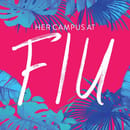It’s November! It’s time for fall and counting down the days until winter break. The last thing on anyone’s mind is spring flowers and April showers. However, Spring is coming; we’re in desperate need of native flowers that help pollinators, like bees and butterflies, survive. Due to climate change and habitat loss, the pollinator population is dwindling. That isn’t good! Honeybees pollinate $10 billion worth of crops each year.
So, what can you do now to benefit our little pollinating pals? Well, start by researching what flowers are native to your area. Native plants are going to be more nutritious to pollinators and allow them to live healthier lives while also bringing biodiversity to your garden.
So, now that you’ve researched what plants are native, where can you buy seeds, plants and all other gardening necessities? Well, there are local flower and garden shops. You can also check Etsy! I recently bought a pack of over 6,000 wildflower seeds that are native to Florida and the Gulf Coast from Zellajake Farm and Garden on Etsy. If you don’t like flowers, research what kind of food grows locally in your hemisphere.
Once you have your seeds what can you do?
- Plant a Garden
-
Have a gorgeous, evergreen, grass lawn? Get rid of it. We need to stop stanning grass lawns. They’re useless! Why would you want to waste resources, water and money on keeping your lawn perfect? Grass lawns do not benefit us in any way, yet we grow grass three times more than any other irrigated crop! That’s just unnecessary. Instead, plant a food garden or a butterfly garden.
If you’re going to be using resources on a grass lawn that doesn’t benefit you, you can easily use them on growing a gorgeous garden that’s going to add color to your home. Butterfly and bee gardens help keep our pollinators healthy and happy.
If you decide to plant a food garden, you could end up saving a ton of money on groceries and fresh produce. Not only will your food be tastier, but your carbon footprint will shrink, too!
- Bombs Away
-
Don’t have space for a garden at home? Make seed bombs! What’s that? Well, it’s paper mache you mix with seeds then sculpt into balls. Carry them around with you! Toss a ball on ugly, patches of dirt to fill it with colorful flowers. As the paper composts into the soil, you’ll begin sprouting a batch of wildflowers.
If you are going to do this, make sure you only use native plants. You could accidentally introduce an invasive plant species that could harm your local ecosystem.
Don’t do this on private property! You can do this at friends’ houses and give them away as gifts. do not throw them on private property, though, or anywhere that could see it as littering. If you’re going to go out in the wild and plan on planting wildflowers everywhere you go, do it at your own risk.
- Make Seed Paper
-
Seed paper is similar to seed bombs, but involves less guerilla gardening. You can use scrap pieces of paper to create new sheets and infuse it with wildflower seeds. Give it to friends or use it for art projects.
With the holidays coming us, you can easily turn seed paper into cute present labels or holiday cards. They can then use it to plant their own little garden.
Seed paper is fun to make, helps you keep paper out of landfills and will save you money when you start sending out holiday cards this year.
We need to help the butterflies and bees. Without pollinators, humans are doomed. Doing little things like this help keep our Earth happy. This isn’t going to fix climate change, but it’s a start.



